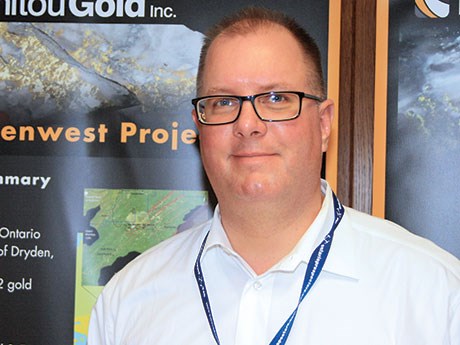New acquisitions, discoveries show promise
This may prove to be an interesting drilling season for Manitou Gold thanks to operations in two different regions of Ontario.
Recent acquisitions in the Goudreau-Lochalsh deformation zone (GLDZ) near Dubreuilville, Ontario, 75 kilometres north of Wawa, signal a new direction for the junior miner. Manitou announced its first acquisitions in October 2017, acquiring 160 acres of patented claims northeast of Alamos Gold Inc.’s nearby Island Gold Mine.
“It’s not a huge property, but it’s a perfect address,” said Manitou CEO Richard Murphy. “The fact that we were able to pick up 160 acres adjacent to a few past-producing mines – and some that have never been drilled – I think that’s the sweetest bit of ground and some of the best acquisitions anyone’s made in a long time.”
Manitou also staked another 164 acres east of the patents, just outside of the GLDZ. Murphy said that it will take some exploration to find out what’s there, noting that it could possibly be a splay of the GLDZ.
“There are definitely anomalies and possibly drill targets,” Murphy said, adding that a soil and gas hydrocarbon survey revealed strong indications of gold mineralization. “We’re chomping at the bit for the snow to melt in May so we can get out there and start prospecting these features.”
As it turned out, these acquisitions were just a small step of a bigger plan. On March 21, 2018, the company announced it had reached a deal with Argo Gold Inc. to purchase the 7,000-acre Rockstar property immediately south of the other claims, instantly making the company a significant exploration player in the area.
Murphy said that he was first attracted to the area when he heard about Richmont Mines’ success with its Island Gold project in the southwestern corner of the GLDZ. (Richmont was purchased by Alamos Gold in 2017 for $933 million).
“They really blew the doors open on the upside potential of the property,” Murphy said.
Manitou president Pat Dubreuil said he introduced Manitou to the idea of the GLDZ, which led to him joining the company soon after.
“I started looking at opportunities in the area about three years ago, and I brought this opportunity to Manitou Gold through some common connections,” said Dubreuil, who is a local entrepreneur and part of Dubreuilville’s namesake family. “Eventually they asked me to become an officer of the board.”
Murphy said that right now the plan is to consolidate drill data from the patented claims, do some prospecting on the claims north of the GLDZ to determine what the magnetic anomaly is, and do some boots-on-the-ground work, data consolidation, and patent work on the Rockstar property. After that, drill plans will depend on what they find and how much capital they can raise, but potentially more drilling could happen later this year.
“Sometimes, not really having a lot of money lets you do the careful work, and then you end up drilling your holes a lot more productively with a much higher success rate,” Murphy said.
Manitou’s original claims in the Manitou Straits Deformation Zone (MSDZ) are showing some promise as well, especially the Kenwest property. Located approximately 50 kilometres south of Dryden, Ontario, along Highway 502, this area is home to past-producing mines dating back 100 years to the Gold Rock ghost town.
What makes the area particularly exciting is that no mining or exploration has been done below 180 metres. In 2011, Manitou cross-drilled a shallow path through two parallel shear zones to a vertical depth of 220 metres. In Shear 1, the core revealed two metres of 8g/t of gold. Shear 2 revealed 0.55 metres of 53,700g/t, Murphy said.
“I’ve never seen more gold in core ever,” he said. Unfortunately, the downturned market led Manitou to enter capital conservation mode.
In 2017, Manitou used Junior Exploration Assistance Program (JEAP) and flow-through funding to resume drilling. Two of 16 core samples found mineralization above 25 g/t, which Manitou dubbed the 1946 Zone. The company also announced in April that testing on bulk samples from Kenwest revealed a 99.4 per cent recovery rate.
Murphy said that future drilling will likely include going to greater depths.
“It will be incumbent upon us to explore this known trend between the 200-metre level and the 500-metre level. It’s going to take a serious investment, but it’s not an unreachable goal in terms of financing.”
The area has attracted other interest as well. Arc Exploration Limited of Australia announced in February that it will acquire 112 claims from GNR Minerals in what it calls its Manitou Gold Project. The claims surround Manitou Gold’s properties.



.jpg;w=120;h=80;mode=crop)